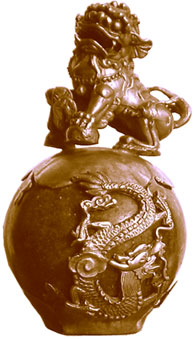


 |
Tai
Chi Chuan or
Taijiquan (literally translated as "supreme ultimate
fist") is an internal Chinese martial art. There
are different styles of Tai Chi Chuan, although most
schools can trace their development to the system originally
taught by the Chen family in 17th century China.
While
it was originally developed as a martial art, today
it is widely promoted and practised for health and
longevity. It is considered a 'soft' or 'internal'
martial art, as deep relaxation or 'softness' in the
musculature is stressed, in contrast to the 'hard'
or 'external' martial art styles (such as Kung Fu)
which use a degree of tension in the muscles.
Traditional
Tai Chi training is intended to teach awareness of
one's own balance and what affects it, awareness of
the same in others, at both mental and physical levels,
and how this applies in a self-defense situation. By
training the "Yi" (mind
or intention), in addition to the physical body, we can learn to feel and then
over time direct our "Qi" (internal energy) both within our own body
and in relation to others.
The physical training of Tai Chi
Chuan develops coordination in relaxation, rather than
muscular tension. The slow, repetitive work involved
in the process of learning gently and measurably increases
and opens the internal circulation: (breath, body heat,
blood, lymph, peristalsis, etc.). Over time, this can
help to reverse the damaging effects of stress on the
human body.
The study of Tai Chi Chuan involves three primary subjects:
• Health
• Meditation
• Martial art |
|
What it involves
All classes
will start with a warm-up to open and loosen the joints,
gently stretch the muscles and increase flexibility, and
relax the body, as well as settle the mind into the body.
Depending on
the style and nature of the class, there will be some training
of basic or foundation exercises, such as silk-reeling exercises,
or stepping practice.
The core training then involves learning a solo
form.
The solo form involves linking together various movements,
which should take the student through a complete, natural,
range of motion over their centre of gravity. Accurate, repeated
practice of the solo routine helps to retrain posture and
develop whole-body coordination, encourage circulation,
maintain flexibility through their joints and can familiarise
the student with the martial application sequences implied
by the forms. Once the external movements and coordination
of the form have been learned to a reasonable degree, the
more internal aspects tend to focused on. This includes the
emphasis and movement of both jin and qi throughout
the form, opening and closing of the body and joints, and
movement of the dantien.
The five main principles that are initially
emphasised in training are:
1. Song - loose, relaxed;
2. Peng - maintaining the structure, supportive loose strength;
3. Ding - lifting upwards, aligned (upright);
4. Chen - rooted (sunk);
5. Chan Si - reeling silk/whole body connectedness
What to expect in your first class
It is important to be comfortable and relaxed when practising
Tai Chi, so in terms of clothing, there is no uniform you
need, but loose comfortable clothing is recommended,
with thin soled shoes. Some people prefer to practise in
bare feet, which is fine as well. If you have
any injuries or concerns, most exercises can be adapted,
so tell the teacher and they can keep an eye on you and suggest
alternative ways of doing a movement if necessary. While
the goal is to be relaxed and learn to move in a natural
and comfortable manner, it does take a while to learn how
to do this - in fact, the learning process is neverending
- so don't be concerned if at first you struggle to grasp
the movements. It is important to remember that the more
practise you do the better your progress will be, and the
more relaxed you are, the easier it will be.
Additonal training
Two-person
work, or pushing
hands, is trained
for 'stickiness' and to learn sensitivity, along with leverage,
timing, coordination and positioning when interacting with
another. It also tends to emphasise general mistakes as these
show up quite obviously through weaknesses when
interacting with another person. The applications implied
in the movements may be practised to help students gain
a clearer understanding of the intention required and the
dynamics of a movement. However, many classes taught primarily
for health reasons will not include much, if any, two-person
work.
Other training exercises include:
Weapons training: including the jian (straight
sword), dao (sabre - also called a broadsword),
gun (wooden staff), qiang (spear) and guan dao (a broadsword
blade mounted atop a 6 ft pole with a pointed metal
counter weight).
Breathing exercises: nei kung or, more
commonly, chi kung (qìgong) to develop chi or "breath
energy" in
coordination with physical movement and standing, or combinations
of the two.
There are five major styles of Tai Chi
Chuan, each
named after the Chinese family from whom they originated:
Chen style
Yang style
Wu or Wu/Hao style of Wu Yu-hsiang (Wu Yuxiang)
Wu style of Wu Ch'uan-yü (Wu Quanyuo) and Wu Chien-ch'uan
(Wu Jianquan)
Sun style
These five
major family styles share much underlying theory, but differ
in their approaches to training. In addition, today there
are now dozens of new styles, hybrid styles and offshoots
of the main styles. |




